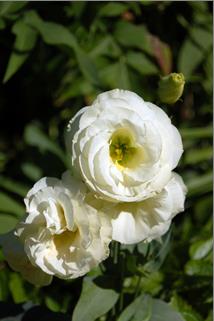Difference between revisions of "Lisianthus (Prairie gentian)"
(Created page with "{{Infobox_Other_organic | image = Lisianthus.jpg | origin = - | stowage factor = - | humidity and ...") |
m (→Special Considerations) |
||
| (3 intermediate revisions by one other user not shown) | |||
| Line 8: | Line 8: | ||
}} | }} | ||
==Description / Shipment / Storage / Risk factors== | ==Description / Shipment / Storage / Risk factors== | ||
| + | ====Scientific Name and Introduction==== | ||
| + | Eustoma grandiflora. Introduced into cultivation from Texas, production of lisianthus has increased dramatically recently, spurred by development mostly in Japan, of excellent cultivars with a wide range of colours, and single and double forms.<br> | ||
| + | ====Quality Characteristics and Criteria==== | ||
| + | Stems are harvested when at least one flower is open. Although requiring extra labour, removal of immature shoots, whose buds will not develop, improves display quality. Choose stems with at least one open flower and several large buds.<br> | ||
| + | ====Grading and Bunching==== | ||
| + | There are no grade standards for lisianthus, but obvious leaf miners and damage to the flower are quality defects. Bunches consist of 10 flower stems.<br> | ||
| + | ====[[Ethylene]] Sensitivity==== | ||
| + | Lisianthus is slightly sensitive to ethylene - exposure of mature flowers to ethylene will decrease their ultimate vase-life, but the effect is relatively slight, and does not warrant treatment with 1-MCP or STS.<br> | ||
| + | ====Pretreatments==== | ||
| + | Lisianthus flowers benefit from sugar in the vase solution, and can respond to pretreatment for 24 h with a preservative containing 5% to 10% sugar.<br> | ||
| + | ====Storage Conditions==== | ||
| + | Lisianthus should be stored at 0°C to 1ºC.<br> | ||
| + | ====Packing==== | ||
| + | Lisianthus flowers are sensitive to gravity, and their stems will bend upwards if the flowers are held horizontal at ambient temperatures. For this reason, lisianthus flowers that will be transported at warmer temperatures are often packed and transported in vertical hampers.<br> | ||
| + | ====Special Considerations==== | ||
| + | Lisianthus is sensitive to some of the biocides in preservatives, which may cause browning of the stems. Aluminum sulfate (200 ppm) and Clorox (50 ppm hypochlorite) are excellent bactericides to use with lisianthus. | ||
| + | br><br><br> | ||
| + | <b>Sources used</b><br> | ||
| + | BMT Consolidated Manual on (Dutch) [[Flower Bulbs]], cut flowers/greens and potted [[plants]]. | ||
| + | [[Category: Products]][[Category: Perishables]] | ||
Latest revision as of 13:06, 14 January 2021
| Infobox on Lisianthus (Prairie gentian) | |
|---|---|
| Example of Lisianthus (Prairie gentian) |  |
| Facts | |
| Origin | - |
| Stowage factor (in m3/t) | - |
| Humidity / moisture | - |
| Ventilation | - |
| Risk factors | See text |
Lisianthus (Prairie gentian)
Contents
Description / Shipment / Storage / Risk factors
Scientific Name and Introduction
Eustoma grandiflora. Introduced into cultivation from Texas, production of lisianthus has increased dramatically recently, spurred by development mostly in Japan, of excellent cultivars with a wide range of colours, and single and double forms.
Quality Characteristics and Criteria
Stems are harvested when at least one flower is open. Although requiring extra labour, removal of immature shoots, whose buds will not develop, improves display quality. Choose stems with at least one open flower and several large buds.
Grading and Bunching
There are no grade standards for lisianthus, but obvious leaf miners and damage to the flower are quality defects. Bunches consist of 10 flower stems.
Ethylene Sensitivity
Lisianthus is slightly sensitive to ethylene - exposure of mature flowers to ethylene will decrease their ultimate vase-life, but the effect is relatively slight, and does not warrant treatment with 1-MCP or STS.
Pretreatments
Lisianthus flowers benefit from sugar in the vase solution, and can respond to pretreatment for 24 h with a preservative containing 5% to 10% sugar.
Storage Conditions
Lisianthus should be stored at 0°C to 1ºC.
Packing
Lisianthus flowers are sensitive to gravity, and their stems will bend upwards if the flowers are held horizontal at ambient temperatures. For this reason, lisianthus flowers that will be transported at warmer temperatures are often packed and transported in vertical hampers.
Special Considerations
Lisianthus is sensitive to some of the biocides in preservatives, which may cause browning of the stems. Aluminum sulfate (200 ppm) and Clorox (50 ppm hypochlorite) are excellent bactericides to use with lisianthus.
br>
Sources used
BMT Consolidated Manual on (Dutch) Flower Bulbs, cut flowers/greens and potted plants.











